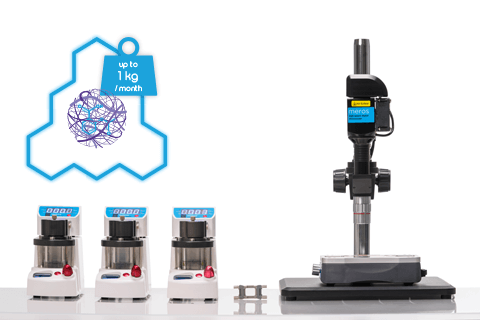Research into efficient and effective drug delivery systems is important in the development of medicines and the future of a personalized approach to treatments. Being able to encapsulate a drug for controlled release has advantages including lower dosage, reduced side-effects, and improved results of the treatment.
Dolomite’s continuous flow, microfluidic method overcomes these obstacles, providing almost 100% encapsulation within precisely controlled, monodisperse PLGA particles, in a reproducible way.
For drug encapsulation to be effective, it’s important that the size, shape, and architecture of the particle is precise and reproducible.
Conventional methods however often result in uneven API distribution and particle polydispersity.
Download detailed notes of microfluidic applications for PLGA particle production.
Methodology for fabrication of monodisperse PLGA beads with sizes ranging from 10 to 40 µm using the Hydrodynamic Flow Focusing Method.

Methodology for fabrication of monodisperse PLGA beads with sizes ranging from 50 nm to 30 µm using the Hydrodynamic Flow Focusing Method.

Methodology for fabrication of highly monodisperse PLGA beads with sizes ranging from 10 µm to 30 µm using the Droplet Method.

This webinar introduced novel Dolomite’s microfluidic methods of precisely controlled PLGA nanoparticle production.
This webinar explored most suitable microfluidic methods of encapsulating hydrophilic active pharmaceutical ingredients (API) in PLGA particles.
This webinar explored how microfluidic encapsulation of hydrophobic active pharmaceutical ingredient (API) in PLGA particles works.

Dolomite’s Drug (API) Encapsulation Systems are the perfect solution for this pharmaceutical application as they utilize microfluidic methods to directly generate monodisperse particles, beads and emulsions, eliminating the need for further processing. They can be used to generate particles in nano and micro size range, resulting in formulations such as water in oil (w/o) or oil in water (o/w) emulsions.

A Dolomite Microfluidics’ set-up is helping researchers in the University of Manchester’s Division of Pharmacy and Optometry to enhance PLGA drug delivery systems for oncology applications, and liposomes for the co-delivery of fat- and water-soluble therapeutics.

The Dolomite Team is using the microfluidic multiple emulsions methodology to encapsulate PLGA for hydrophilic drug delivery.

Read about how researchers in the School of Pharmacy at the University of Nottingham have been using Dolomite Microfluidic’s chips to enhance their work on drug encapsulation and therapeutic delivery.